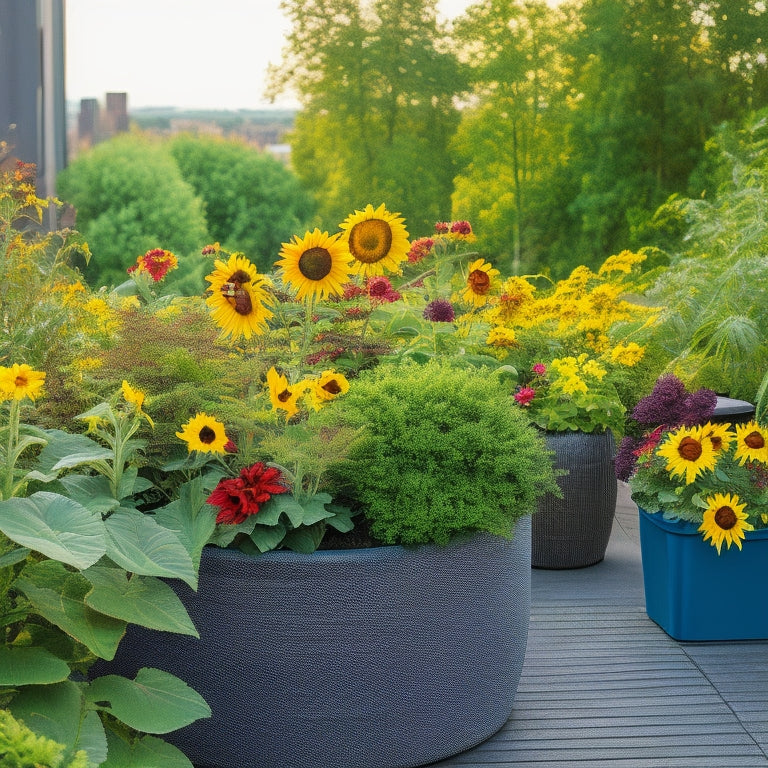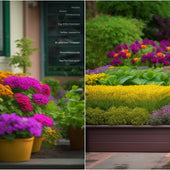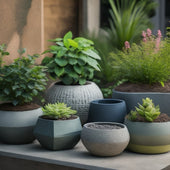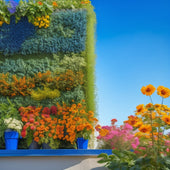
What to Plant in a Rooftop Container Garden
Share
When creating a rooftop container garden, you'll want to choose plants that can thrive in harsh conditions. Consider compact herbs like basil, cilantro, and parsley, which can tolerate wind, extreme temperatures, and intense sunlight. Succulents are also a great option, as they come in a variety of shapes and sizes and are low maintenance. If you're looking for edibles, compact vegetables like cherry tomatoes, carrots, and radishes do well in containers. Don't forget to select containers that can withstand the elements and provide adequate drainage. By choosing the right plants and containers, you'll be on your way to a thriving rooftop oasis that's uniquely yours to enjoy.
Small Space Container Garden
When designing a small space container garden on your rooftop, you'll need to maximize every inch of space, choosing compact plants and cleverly arranging containers to create a thriving oasis in even the most limited areas.
Succulent arrangements are ideal for small spaces, as they're low-maintenance and can thrive in shallow containers. Balcony flowers like petunias, geraniums, and begonias are also great options, as they're compact and produce vibrant blooms.
To make the most of your rooftop space, consider using hanging planters to add depth and visual interest. These can be hung from the railing or attached to the wall, freeing up floor space for other containers.
When selecting containers, look for ones that are specifically designed for small space gardening. These often have built-in water reservoirs and aeration systems to help plants thrive in tight spaces.
Vertical Gardening Ideas
By incorporating vertical gardening elements, such as trellises, arbors, or living walls, you can exponentially increase your rooftop container garden's growing capacity while adding a striking visual dimension to the space.
Hanging planters, for instance, can be suspended from the rooftop's railing or a freestanding structure, providing additional growing space without taking up valuable floor area. Consider a trellis design that incorporates a built-in irrigation system to optimize water distribution and reduce evaporation.
If you're looking to create a more dramatic effect, consider installing a living wall or succulent wall. These vertical hydroponics systems can be tailored to fit your specific climate and plant selection, providing a stunning visual display while maximizing space. By using a modular system, you can easily swap out plants or adjust the layout as needed.
With proper planning and execution, your rooftop container garden can become a lush oasis that not only provides a bounty of fresh produce but also serves as a tranquil retreat from the hustle and bustle of city life.
Rooftop Herb Garden Layout
When designing your rooftop herb garden layout, you'll need to ponder three key factors to guarantee a thriving and functional space.
First, you'll select herbs that are well-suited to your rooftop's conditions and your personal preferences.
Then, you'll choose containers that are the right size and shape to accommodate your herbs, while also providing adequate sunlight and wind protection.
Herb Selection Criteria
You'll want to choose herbs that thrive in containers, tolerate wind, and can handle full sun to partial shade, as rooftop conditions can be quite different from those on the ground.
When selecting herbs for your rooftop container garden, consider the following key factors:
-
Soil composition and drainage: Herbs need well-draining soil to prevent waterlogged roots. Look for mixes specifically designed for containers with good aeration and moisture retention.
-
Watering schedule and sunlight requirements: Herbs have varying watering needs, so group them according to their requirements. Some herbs, like basil, require full sun, while others, like mint, prefer partial shade.
-
Wind tolerance: Rooftop gardens can be windy, so choose herbs that can withstand gusts, such as rosemary or thyme.
-
Temperature range: Herbs have ideal temperature ranges, so select those that fit your rooftop's temperature fluctuations.
-
Growth habits and pruning needs: Consider herbs with compact growth habits, like parsley or cilantro, which require less pruning and maintenance.
Container Size and Shape
Once you've chosen the ideal herbs for your rooftop garden, think about the container size and shape that will best accommodate their growth habits and space requirements.
A larger container will provide more room for root growth and reduce the need for frequent watering, but may compromise on space optimization. On the other hand, smaller containers can be more aesthetically pleasing, but may require more frequent watering.
When selecting a container, make sure it has a proper drainage system to prevent waterlogged soil. A well-designed drainage system will also lower the risk of root rot and other diseases. Consider the mature size of your herbs and leave enough space for air circulation and pruning.
Choose a container shape that complements the herb's growth habit. For instance, tall, upright herbs like rosemary or thyme do well in narrow, deep containers, while spreading herbs like mint or oregano thrive in shallow, wide containers.
Sunlight and Wind Protection
Position your rooftop herb garden to maximize sunlight exposure, taking into account the direction your roof faces and the time of day the sun shines brightest. Most herbs require at least 4-6 hours of direct sunlight per day, so choose a location that receives ideal sun exposure.
Consider the following factors to guarantee your rooftop herb garden thrives:
-
Direction: If your roof faces south, you'll get the most direct sunlight. East- and west-facing roofs will receive morning and afternoon sun, respectively.
-
Time of day: If possible, position your garden to receive morning sun, as it's gentler on plants than harsh afternoon sun.
-
Shading techniques: Use umbrellas, canopies, or trellises to provide shade during intense sun periods or for plants that require partial shade.
-
Wind protection: Install windbreaks, such as screens or trellises, to shield your plants from harsh rooftop winds.
-
Structural considerations: Guarantee your rooftop can support the weight of your containers, soil, and plants, and that your garden is securely anchored to prevent wind damage.
Container Size and Material
When selecting containers for your rooftop garden, you'll want to take into account both size and material.
You'll need to choose containers that can endure harsh weather conditions and provide sufficient room for your plants' roots to grow.
Material Durability Matters
You'll want to select a rooftop container that can endure the elements, as the material's durability directly impacts the garden's overall health and your maintenance workload. A durable container will prevent cracks, leaks, and other damage that can lead to soil erosion, waterlogging, and root rot.
When choosing a container, consider the following factors:
-
Weather resistance: Look for materials that can withstand extreme temperatures, UV rays, and harsh weather conditions.
-
Aesthetic appeal: Select a container that complements your rooftop's style and architecture.
-
Weight capacity: Ensure the container can bear the weight of the soil, plants, and water without compromising its structural integrity.
-
Drainage system: Choose a container with a built-in drainage system or add a layer of drainage material to prevent waterlogging.
-
Maintenance requirements: Opt for a material that's easy to clean and maintain, such as fiberglass or plastic.
Container Depth Options
Your rooftop container garden's success hinges on selecting the right container depth, as it directly impacts soil volume, root growth, and overall plant health. A deeper container allows for more soil volume, which means improved soil composition and structure. This, in turn, enables healthy root growth and supports the plant's water and nutrient uptake.
However, you'll need to balance depth with container drainage to prevent waterlogged soil. A minimum of 5-7 gallons of soil per container is recommended, but you can choose deeper containers (10-15 gallons) for larger plants or those with extensive root systems.
When choosing a container, consider the material and its drainage capabilities. For instance, plastic or ceramic containers with built-in drainage holes can help prevent waterlogging. Alternatively, you can add a layer of drainage material, such as perlite or vermiculite, to the bottom of the container to enhance soil aeration and drainage.
Rooftop Vegetable Selection
Selecting vegetables that thrive in rooftop container gardens requires careful consideration of factors such as wind, sunlight, and temperature fluctuations. You'll want to choose varieties that are tolerant of these conditions and can thrive in shallow soil depths.
When selecting vegetables, consider the following options:
-
Root vegetable options: Carrots, beets, and radishes are perfect for rooftop containers as they don't require a lot of space and can tolerate wind and temperature fluctuations.
-
Leafy greens like lettuce, kale, and spinach are also great choices as they're easy to grow and can thrive in partial shade.
-
Seasonal fruit varieties: Strawberries and blueberries are excellent options for rooftop containers as they're compact, produce fruit quickly, and can tolerate wind and sun exposure.
-
Cherry tomatoes and patio tomatoes are great choices for rooftop containers as they're compact, produce fruit quickly, and can thrive in sunny conditions.
-
Herbs like basil, cilantro, and parsley are also perfect for rooftop containers as they're easy to grow, can tolerate wind and sun exposure, and add fresh flavor to a variety of dishes.
Balcony Shade Container Options
While rooftop vegetable selection is key to a thriving container garden, not all balconies receive direct sunlight, making it necessary to choose shade-tolerant containers that can still provide ideal growing conditions.
If your balcony receives partial shade, you'll want to opt for containers that can thrive in low-light conditions. Hanging planters are a great creative solution for balconies with limited space, and they can add a touch of elegance to your outdoor area.
For a modern decor, consider succulent arrangements that can tolerate shade. These low-maintenance plants come in a variety of shapes, sizes, and colors, making them perfect for adding visual interest to your balcony.
When selecting shade-tolerant plants, look for varieties that are specifically bred for low-light conditions. Some popular options include coleus, impatiens, and ferns. By choosing the right plants and containers, you can create a thriving rooftop container garden even in partial shade.
With a little creativity, you can turn your balcony into a beautiful oasis that provides a peaceful retreat from the hustle and bustle of city life.
Frequently Asked Questions
How Often Should I Water My Rooftop Container Garden?
As you gaze out at your rooftop oasis, you wonder: how often should I water? It depends on your watering schedule, which is influenced by plant selection, container size, and drainage requirements - all vital factors to prevent overwatering or underwatering.
Will Strong Winds Damage My Rooftop Container Plants?
You'll need to guarantee wind protection and plant stability by anchoring containers securely, using heavy containers, and grouping plants together. Also, consider container weight and structural concerns to prevent damage from strong winds.
Can I Use a Rooftop Container Garden in a High-Rise Building?
You can create a thriving rooftop container garden in a high-rise building, but be aware of rooftop garden challenges like wind and weight loads, and design with rooftop garden benefits in mind, prioritizing clever design and regular maintenance.
Do Rooftop Container Gardens Attract Pests or Rodents?
Like a magnet, your rooftop oasis can attract unwanted visitors! You'll want to prioritize pest prevention and rodent control through savvy plant selection and maintenance strategies to keep your haven pest-free and thriving.
Are Rooftop Container Gardens Suitable for Beginners?
You'll find rooftop container gardens surprisingly accessible as a beginner, thanks to flexible container selection and forgiving plant choices. Just remember to prioritize maintenance tips, like regular watering and pruning, and guarantee your plants receive sufficient sunlight requirements.
Related Posts
-

Optimal Soil Ph for Planter Boxes Made Easy
You need to optimize your planter box's soil pH to create a thriving environment for your plants, as the ideal pH ran...
-

Optimal Soil Ph for Planter Boxes Made Easy
You need to optimize your planter box's soil pH to create a thriving environment for your plants, as the ideal pH ran...
-

Optimal Soil Ph for Planter Boxes Made Easy
You need to optimize your planter box's soil pH to create a thriving environment for your plants, as the ideal pH ran...
-

Optimal Soil Ph for Planter Boxes Made Easy
You need to optimize your planter box's soil pH to create a thriving environment for your plants, as the ideal pH ran...
-

Optimal Soil Ph for Planter Boxes Made Easy
You need to optimize your planter box's soil pH to create a thriving environment for your plants, as the ideal pH ran...
-

Optimal Soil Ph for Planter Boxes Made Easy
You need to optimize your planter box's soil pH to create a thriving environment for your plants, as the ideal pH ran...
-

Optimal Soil Ph for Planter Boxes Made Easy
You need to optimize your planter box's soil pH to create a thriving environment for your plants, as the ideal pH ran...
-

Optimal Soil Ph for Planter Boxes Made Easy
You need to optimize your planter box's soil pH to create a thriving environment for your plants, as the ideal pH ran...
-

Optimal Soil Ph for Planter Boxes Made Easy
You need to optimize your planter box's soil pH to create a thriving environment for your plants, as the ideal pH ran...
-

Optimal Soil Ph for Planter Boxes Made Easy
You need to optimize your planter box's soil pH to create a thriving environment for your plants, as the ideal pH ran...
-

Optimal Soil Ph for Planter Boxes Made Easy
You need to optimize your planter box's soil pH to create a thriving environment for your plants, as the ideal pH ran...
-

Optimal Soil Ph for Planter Boxes Made Easy
You need to optimize your planter box's soil pH to create a thriving environment for your plants, as the ideal pH ran...
-

Optimal Soil Ph for Planter Boxes Made Easy
You need to optimize your planter box's soil pH to create a thriving environment for your plants, as the ideal pH ran...
-

Optimal Soil Ph for Planter Boxes Made Easy
You need to optimize your planter box's soil pH to create a thriving environment for your plants, as the ideal pH ran...
-

Optimal Soil Ph for Planter Boxes Made Easy
You need to optimize your planter box's soil pH to create a thriving environment for your plants, as the ideal pH ran...
-

Optimal Soil Ph for Planter Boxes Made Easy
You need to optimize your planter box's soil pH to create a thriving environment for your plants, as the ideal pH ran...
-

Optimal Soil Ph for Planter Boxes Made Easy
You need to optimize your planter box's soil pH to create a thriving environment for your plants, as the ideal pH ran...
-

Optimal Soil Ph for Planter Boxes Made Easy
You need to optimize your planter box's soil pH to create a thriving environment for your plants, as the ideal pH ran...
-

Optimal Soil Ph for Planter Boxes Made Easy
You need to optimize your planter box's soil pH to create a thriving environment for your plants, as the ideal pH ran...
-

Optimal Soil Ph for Planter Boxes Made Easy
You need to optimize your planter box's soil pH to create a thriving environment for your plants, as the ideal pH ran...
-

Optimal Soil Ph for Planter Boxes Made Easy
You need to optimize your planter box's soil pH to create a thriving environment for your plants, as the ideal pH ran...
-

Optimal Soil Ph for Planter Boxes Made Easy
You need to optimize your planter box's soil pH to create a thriving environment for your plants, as the ideal pH ran...
-

Optimal Soil Ph for Planter Boxes Made Easy
You need to optimize your planter box's soil pH to create a thriving environment for your plants, as the ideal pH ran...
-

Optimal Soil Ph for Planter Boxes Made Easy
You need to optimize your planter box's soil pH to create a thriving environment for your plants, as the ideal pH ran...
-

Optimal Soil Ph for Planter Boxes Made Easy
You need to optimize your planter box's soil pH to create a thriving environment for your plants, as the ideal pH ran...
-

Optimal Soil Ph for Planter Boxes Made Easy
You need to optimize your planter box's soil pH to create a thriving environment for your plants, as the ideal pH ran...
-

5 Best DIY Planter Ideas to Upcycle Concrete
You're about to breathe new life into discarded concrete blocks by transforming them into functional and visually app...
-

5 Best DIY Planter Ideas to Upcycle Concrete
You're about to breathe new life into discarded concrete blocks by transforming them into functional and visually app...
-

5 Best DIY Planter Ideas to Upcycle Concrete
You're about to breathe new life into discarded concrete blocks by transforming them into functional and visually app...
-

5 Best DIY Planter Ideas to Upcycle Concrete
You're about to breathe new life into discarded concrete blocks by transforming them into functional and visually app...
-

5 Best DIY Planter Ideas to Upcycle Concrete
You're about to breathe new life into discarded concrete blocks by transforming them into functional and visually app...
-

5 Best DIY Planter Ideas to Upcycle Concrete
You're about to breathe new life into discarded concrete blocks by transforming them into functional and visually app...
-

5 Best DIY Planter Ideas to Upcycle Concrete
You're about to breathe new life into discarded concrete blocks by transforming them into functional and visually app...
-

5 Best DIY Planter Ideas to Upcycle Concrete
You're about to breathe new life into discarded concrete blocks by transforming them into functional and visually app...
-

5 Best DIY Planter Ideas to Upcycle Concrete
You're about to breathe new life into discarded concrete blocks by transforming them into functional and visually app...
-

5 Best DIY Planter Ideas to Upcycle Concrete
You're about to breathe new life into discarded concrete blocks by transforming them into functional and visually app...
-

5 Best DIY Planter Ideas to Upcycle Concrete
You're about to breathe new life into discarded concrete blocks by transforming them into functional and visually app...
-

5 Best DIY Planter Ideas to Upcycle Concrete
You're about to breathe new life into discarded concrete blocks by transforming them into functional and visually app...
-

5 Best DIY Planter Ideas to Upcycle Concrete
You're about to breathe new life into discarded concrete blocks by transforming them into functional and visually app...
-

5 Best DIY Planter Ideas to Upcycle Concrete
You're about to breathe new life into discarded concrete blocks by transforming them into functional and visually app...
-

5 Best DIY Planter Ideas to Upcycle Concrete
You're about to breathe new life into discarded concrete blocks by transforming them into functional and visually app...
-

5 Best DIY Planter Ideas to Upcycle Concrete
You're about to breathe new life into discarded concrete blocks by transforming them into functional and visually app...
-

5 Best DIY Planter Ideas to Upcycle Concrete
You're about to breathe new life into discarded concrete blocks by transforming them into functional and visually app...
-

5 Best DIY Planter Ideas to Upcycle Concrete
You're about to breathe new life into discarded concrete blocks by transforming them into functional and visually app...
-

5 Tips for Thriving Vertical Vegetable Gardens
To thrive in vertical vegetable gardening, you'll want to choose a planter that meets the unique needs of your veggie...
-

5 Tips for Thriving Vertical Vegetable Gardens
To thrive in vertical vegetable gardening, you'll want to choose a planter that meets the unique needs of your veggie...
-

5 Tips for Thriving Vertical Vegetable Gardens
To thrive in vertical vegetable gardening, you'll want to choose a planter that meets the unique needs of your veggie...
-

5 Tips for Thriving Vertical Vegetable Gardens
To thrive in vertical vegetable gardening, you'll want to choose a planter that meets the unique needs of your veggie...
-

5 Tips for Thriving Vertical Vegetable Gardens
To thrive in vertical vegetable gardening, you'll want to choose a planter that meets the unique needs of your veggie...
-

5 Tips for Thriving Vertical Vegetable Gardens
To thrive in vertical vegetable gardening, you'll want to choose a planter that meets the unique needs of your veggie...
-

5 Tips for Thriving Vertical Vegetable Gardens
To thrive in vertical vegetable gardening, you'll want to choose a planter that meets the unique needs of your veggie...
-

5 Tips for Thriving Vertical Vegetable Gardens
To thrive in vertical vegetable gardening, you'll want to choose a planter that meets the unique needs of your veggie...
-

5 Tips for Thriving Vertical Vegetable Gardens
To thrive in vertical vegetable gardening, you'll want to choose a planter that meets the unique needs of your veggie...
-

5 Tips for Thriving Vertical Vegetable Gardens
To thrive in vertical vegetable gardening, you'll want to choose a planter that meets the unique needs of your veggie...
-

5 Tips for Thriving Vertical Vegetable Gardens
To thrive in vertical vegetable gardening, you'll want to choose a planter that meets the unique needs of your veggie...
-

5 Tips for Thriving Vertical Vegetable Gardens
To thrive in vertical vegetable gardening, you'll want to choose a planter that meets the unique needs of your veggie...
-

5 Tips for Thriving Vertical Vegetable Gardens
To thrive in vertical vegetable gardening, you'll want to choose a planter that meets the unique needs of your veggie...
-

5 Tips for Thriving Vertical Vegetable Gardens
To thrive in vertical vegetable gardening, you'll want to choose a planter that meets the unique needs of your veggie...
-

5 Tips for Thriving Vertical Vegetable Gardens
To thrive in vertical vegetable gardening, you'll want to choose a planter that meets the unique needs of your veggie...
-

5 Tips for Thriving Vertical Vegetable Gardens
To thrive in vertical vegetable gardening, you'll want to choose a planter that meets the unique needs of your veggie...
-

5 Tips for Thriving Vertical Vegetable Gardens
To thrive in vertical vegetable gardening, you'll want to choose a planter that meets the unique needs of your veggie...


